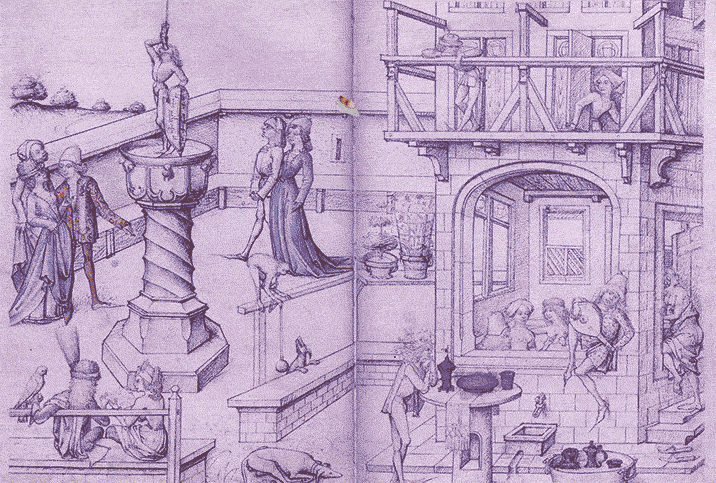From Spas to Brothels to Sex Clubs: A Brief History of Bathhouses

In an era when a bathroom is a fixture of every modern home, the bathhouse no longer occupies the central, sexual role in society it once did. While some cultures have retained a rich bathhouse tradition dating back centuries—like the Japanese sentō, the Russian banya or the Islamic hammam—in the modern Western world, bathhouses have been pushed to the margins and are now primarily better known as sex clubs to the LGBTQIA+ community.
But for much of human history, public bathing was the norm, and bathhouses were often the place to do it. Throughout their history, bathhouses have played many other roles beyond just getting clean, including revealing much about the communities that visited them.
As Katherine Ashenburg wrote in her history of hygiene, "The Dirt on Clean: An Unsanitized History," in 2007: "Show me a people's bathhouses and bathrooms, and I will show you what they desire, what they ignore, sometimes what they fear—and a significant part of who they are."
Bathhouses in ancient Greece and Rome
While the earliest public bathhouses date back to 2500 BC in the Indus Valley Civilization in the northwestern regions of South Asia, it was the ancient Greeks who offered the first real evidence of a widespread bathhouse culture. The Greek bathhouse was an important social center where poor and rich alike could enjoy cold baths or warm steam baths, while drinking wine, eating snacks and playing games such as dice and knucklebones.
It was the Romans, though, who would elevate the bathhouse to new heights of luxury. During the pinnacle of its Imperial power, the Romans built lavish bathhouses called thermae, which were massive complexes for bathing and leisure. The Baths of Trajan, for example, included not just large hot and cold water pools, but also libraries, club rooms, lecture halls and exercise spaces.
Roman baths also offered some of the earliest evidence of an open link between public bathhouses and sex, according to Ashenburg. Brothels often operated near the public baths—if not in the same building—and in the Suburban Baths of Pompeii, frescoes of oral and group sex were painted on the walls.
Medieval bathhouses
The decline of the Roman empire also brought with it the decline of the bathhouse in the Western world. Neither the conquering Germanic tribes nor the growing body of Christendom was interested in maintaining the Roman bathhouses, Ashenburg wrote, and until about the 11th century, there is little historical evidence of established bathing standards among Europeans—public or otherwise.
But widespread disdain for hygiene would change around the 11th century, when returning Crusaders brought back news of Muslim hammams they'd encountered in the Levant. Inspired by stories of luxurious Turkish baths, Medieval Europeans built their own bathhouses, which for centuries offered not just communal bathing but "plentiful opportunities for sexual hijinks," Ashenburg wrote.
In Medieval literature, the bathhouse had a particular reputation as a place for infidelity. Sex work was not uncommon, either, such that the slang term "stew"—which originally referred to the wet warmth of a bathhouse—would later come to mean "brothel."
The brief bathing revival of the Middle Ages came to a swift end with the Black Death of 1347. Over four years, bubonic plague killed 1 in 3 Europeans, and bathhouses were quickly shuttered as the disease tore across Europe.
It was not the bathhouses per se, but bathing itself that was blamed for spreading the plague. Medieval physicians came to the conclusion that hot baths—which open up the pores of the skin—made people more susceptible to getting sick.
French historian Jules Michelet called the era "a thousand years without a bath" (though it was closer to 400 years).
The Victorian bathhouse
In the 18th century, Europeans began to associate bathing with health, virtue and progress, and by the 19th century, medical experts completely reversed their position, now asserting it was unhealthy not to open one's pores regularly.
Indeed, the Victorian era saw something of a bathhouse renaissance in North America and the United Kingdom. Upper classes of the Victorian era bathed in luxurious bathhouses, which grew into elaborate facilities, not unlike those of their Roman predecessors. According to The Dig, a historical podcast, Victorian Turkish-stye baths featured large communal hot and cold water pools, and facilities where patrons could exercise, get massages, haircuts and mani-pedis, or relax in the lounging areas and private rooms.
These private rooms, in particular, became popular for casual sex and sex work, and reputations were soon earned, both for cis-gender and same-sex encounters.
The birth of the gay bathhouse
According to community historian Allan Bérubé, by the start of the 20th century, there were certain bathhouses throughout North America and the U.K. that gay patrons identified as "favorite spots"—that is, a club that was considered relatively safe to meet and have sex.
Remember that engaging in same-sex relations—particularly in a semi-public space—was always dangerous in an era when homosexuality was outlawed as a crime against nature. Gay hookups in the early-20th-century bathhouses always carried the risk of jail time, with police officers lurking around bathhouses, spying through peepholes and entrapping patrons.
Despite the ever-present threat of legal redress, the first bathhouses primarily oriented toward gay clientele emerged in the U.S. in the 1930s. These early institutions were no different in appearance from other bathhouses, except that they had private rooms that could be locked and more permissive management.
By the 1950s, bathrooms in private homes were becoming the norm, and the need for bathhouses declined. However, from the 1960s through the 1980s, gay bathhouses grew more complex, adding amenities such as video theaters, snack bars, dance floors and workout centers. Many built extensive networks of rooms that modeled cruising spots of the past: underground hedge mazes with surreptitious hiding spots, bathrooms with glory holes, YMCA steam rooms and even fake jail cells.
Gay hookups in the early-20th-century bathhouses always carried the risk of jail time, with police officers lurking around bathhouses, spying through peepholes and entrapping patrons.
The culture of the gay bathhouses during this heyday was "hedonistic," according to Ron Ehemann, a prominent figure in Chicago's early gay rights movement and the city's first openly gay attorney. Ehemann was the co-owner of Man's Country, Chicago's oldest gay bathhouse, which originally opened its doors in 1971.
Sex was out in the open at Man's Country, from beanbag chairs surrounding the dance floors to the sundeck to the dark orgy rooms where "nobody knew who was doing what to who," Ehemann said. But many people who visited Man's Country never had sex, he added—they came to dance, relax after a night at the bars or even spend the weekend in good company.
Taking on a larger role than a sex club, the gay bathhouses offered a safe haven where the fledgling LGBTQIA+ community began to take shape. Bérubé wrote that the bathhouses were one of the first and few public places where gay people could enjoy a sense of community and experience intimacy with minimal threat of arrest, imprisonment or loss of reputation.
The 1980s, AIDS and the bathhouse
Just as happened in the Middle Ages over the Black Death, the '80s experienced a pandemic that would alter the image of the bathhouse once again. In 1981, gay men began dying of a new disease, initially called GRID—or "gay-related immune deficiency"—but later came to be known as acquired immune deficiency syndrome, or AIDS.
For the first few years, no one was quite certain how this terrifying sickness spread—only that it centered around the gay community. And gay bathhouses and bars saw a sharp decline in attendance, Ehemann noted, as rumors flew.
"'Maybe it's poppers' or 'maybe you shouldn't take a freezing shower,'" he explained.
"[They] were coming up with all sorts of crazy explanations for why some people were getting sick and some people weren't, and the business at the bathhouse started dropping off."
In San Francisco, there was a long-fought battle over whether to close the gay baths. The Washington Post would later dub it "The Bathhouse War." Bérubé himself wrote in favor of bathhouses staying open, arguing to preserve spaces uniquely positioned to offer outreach, education and sexual health resources to their clientele.
Bathhouses that remained open across the U.S. became a locus of community education and health during the AIDS crisis.
In 1984, San Francisco issued an order to shutter their bathhouses, though this proved difficult to enforce. Bathhouses that remained open across the U.S. did, as Bérubé argued, became a locus of community education and health during the AIDS crisis, including Man's Country.
"Man's Country worked closely with the Chicago Department of Health, and we brought them in for education," Ehemann said. "We worked with them to not only distribute condoms in the club, but we organized the distribution of condoms out in the community, in their clubs, organizations [and] bars."
Still, the culture of the gay bathhouse was irreparably altered post-AIDS epidemic, even after the link between unprotected sex and HIV became clear. The free-love orgiastic spirit of their glory days had vanished, of course, but so had the bathhouse's role as a gay community hub, as many either closed or scaled back their amenities and events in the face of declining business.
"A lot of people would never dream of going back to a bathhouse, and especially the younger people," Ehemann said. "The notion of going to the bathhouse and staying there for several days or going up to party on the dance floor, that all changed."
Bathhouses in the time of COVID-19
Post-AIDS, many gay bathhouses that remained open transitioned to a stripped-down, utilitarian model that Ehemann called "lockers and rooms." That is sex clubs with minimal facilities.
Whether it was the long shadow of AIDS, a changing LGBTQIA+ culture or the broader decline of brick-and-mortar establishments, the institution of the gay bathhouse never returned to its former glory. It wasn't just the baths, either—other physical gathering spots for the gay community have also experienced a steady drop in clientele, with one study from the Socius journal showing the average gay bar attendance has trended downward since the late '80s.
In 2020, yet another pandemic struck a blow to the already struggling bathhouse business. During the early stages of COVID-19, cities around the world ordered the closure of nonessential businesses, and many historic gay bathhouses that valiantly kept going after AIDS didn't survive the new lockdown.
Man's Country shut its doors in 2015, though Ehemann thought "the business would have been killed by COVID-19 had they stayed open." For its last hurrah, Man's Country threw a series of multi-day parties that drew in a younger crowd of LGBTQIA+ people. Uninitiated with bathhouses and entranced by the experience, many begged Ehemann not to close. For that brief moment, he said, "it felt like the pre-AIDS days."
But this doesn't mean all gay bathhouses have closed their doors.
Where are legal bathhouses?
Steamworks, a chain of gay men's bathhouses still operate (with vast popularity) in Chicago, Toronto, Vancouver, Berkeley and Seattle.
Now that the country is slowly emerging from the isolation of its most recent pandemic, Ehemann hopes for a comeback to the social model of the bathhouse, and "not just lockers and rooms but a place that, like its 20th-century heyday, offers a safe and joyful multipurpose space for pleasure, intimacy and social connection."
"Could bathhouses have a resurgence?" he asked himself. "I think so. I think we're primed for it. I think that the younger crowd, particularly, is thinking they missed something and would like to see it come back."


















